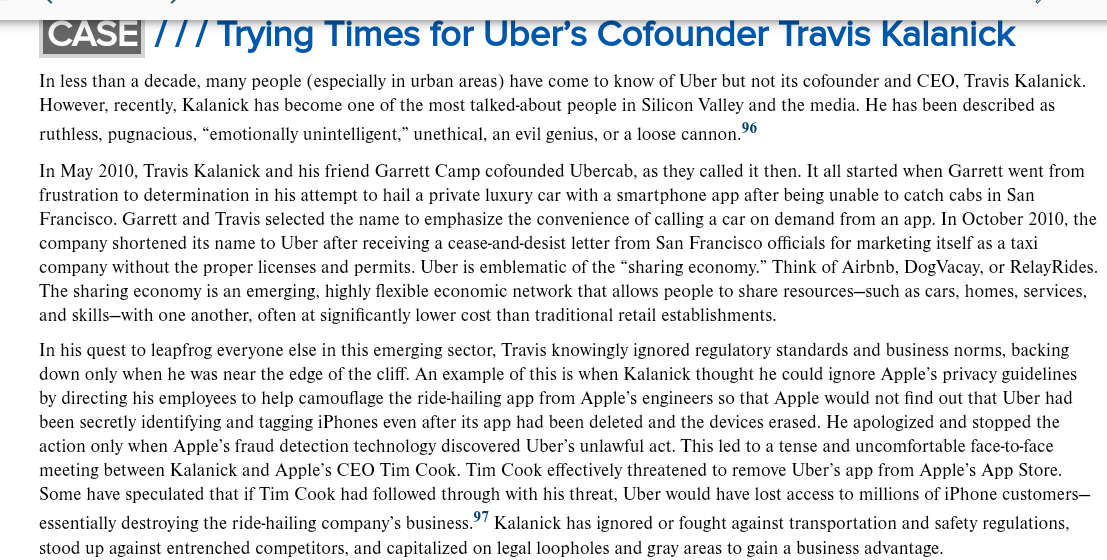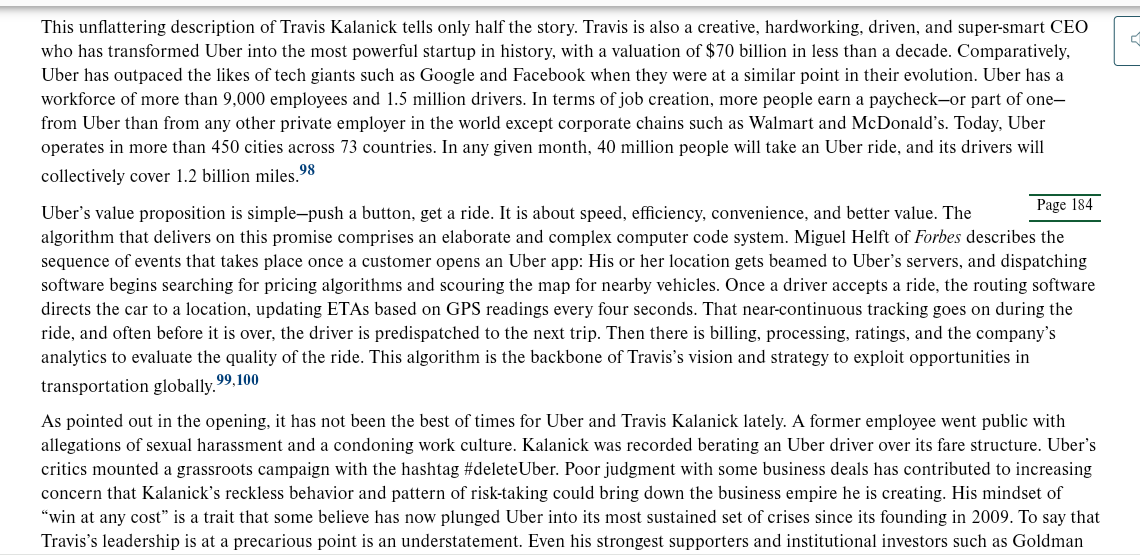CASE /// Trying Times for Uber's Cofounder Travis Kalanick In less than a decade, many people (especially in urban areas) have come to know of Uber but not its cofounder and CEO, Travis Kalanick. However, recently, Kalanick has become one of the most talked-about people in Silicon Valley and the media. He has been described as 96 ruthless, pugnacious, "emotionally unintelligent," unethical, an evil genius, or a loose cannon. In May 2010, Travis Kalanick and his friend Garrett Camp cofounded Ubercab, as they called it then. It all started when Garrett went from frustration to determination in his attempt to hail a private luxury car with a smartphone app after being unable to catch cabs in San Francisco. Garrett and Travis selected the name to emphasize the convenience of calling a car on demand from an app. In October 2010, the company shortened its name to Uber after receiving a cease-and-desist letter from San Francisco officials for marketing itself as a taxi company without the proper licenses and permits. Uber is emblematic of the "sharing economy." Think of Airbnb, DogVacay, or RelayRides. The sharing economy is an emerging, highly flexible economic network that allows people to share resources-such as cars, homes, services, and skills with one another, often at significantly lower cost than traditional retail establishments. In his quest to leapfrog everyone else in this emerging sector, Travis knowingly ignored regulatory standards and business norms, backing down only when he was near the edge of the cliff. An example of this is when Kalanick thought he could ignore Apple's privacy guidelines by directing his employees to help camouflage the ride-hailing app from Apple's engineers so that Apple would not find out that Uber had been secretly identifying and tagging iPhones even after its app had been deleted and the devices erased. He apologized and stopped the action only when Apple's fraud detection technology discovered Uber's unlawful act. This led to a tense and uncomfortable face-to-face meeting between Kalanick and Apple's CEO Tim Cook. Tim Cook effectively threatened to remove Uber's app from Apple's App Store. Some have speculated that if Tim Cook had followed through with his threat, Uber would have lost access to millions of iPhone customers- essentially destroying the ride-hailing company's business.97 Kalanick has ignored or fought against transportation and safety regulations, stood up against entrenched competitors, and capitalized on legal loopholes and gray areas to gain a business advantage. C This unflattering description of Travis Kalanick tells only half the story. Travis is also a creative, hardworking, driven, and super-smart CEO who has transformed Uber into the most powerful startup in history, with a valuation of $70 billion in less than a decade. Comparatively, Uber has outpaced the likes of tech giants such as Google and Facebook when they were at a similar point in their evolution. Uber has a workforce of more than 9,000 employees and 1.5 million drivers. In terms of job creation, more people earn a paycheck-or part of one- from Uber than from any other private employer in the world except corporate chains such as Walmart and McDonald's. Today, Uber operates in more than 450 cities across 73 countries. In any given month, 40 million people will take an Uber ride, and its drivers will collectively cover 1.2 billion miles.98 Page 184 Uber's value proposition is simple-push a button, get a ride. It is about speed, efficiency, convenience, and better value. The algorithm that delivers on this promise comprises an elaborate and complex computer code system. Miguel Helft of Forbes describes the sequence of events that takes place once a customer opens an Uber app: His or her location gets beamed to Uber's servers, and dispatching software begins searching for pricing algorithms and scouring the map for nearby vehicles. Once a driver accepts a ride, the routing software directs the car to a location, updating ETAs based on GPS readings every four seconds. That near-continuous tracking goes on during the ride, and often before it is over, the driver is predispatched to the next trip. Then there is billing, processing, ratings, and the company's analytics to evaluate the quality of the ride. This algorithm is the backbone of Travis's vision and strategy to exploit opportunities in ,99,100 transportation globally." As pointed out in the opening, it has not been the best times for Uber and Travis Kalanick lately. A former employee went public with allegations of sexual harassment and a condoning work culture. Kalanick was recorded berating an Uber driver over its fare structure. Uber's critics mounted a grassroots campaign with the hashtag #deleteUber. Poor judgment with some business deals has contributed to increasing concern that Kalanick's reckless behavior and pattern of risk-taking could bring down the business empire he is creating. His mindset of "win at any cost" is a trait that some believe has now plunged Uber into its most sustained set of crises since its founding in 2009. To say that Travis's leadership is at a precarious point is an understatement. Even his strongest supporters and institutional investors such as Goldman
Sachs have put pressure on him to change. On April 25, 2017, CNBC reported that these scandals may have knocked $10 billion off Uber’s value.
Travis has publicly apologized for some of his behavior and acknowledged that he needs management help. On June 6, 2017, Uber announced that it fired more than 20 employees as a result of the investigation. On June 13, 2017, Kalanick took an indefinite leave of absence from Uber. On June 20, 2017, after multiple shareholders reportedly demanded his resignation, Kalanick resigned as CEO. Only time will tell how Uber will perform without its founding CEO.
1. The text describes four conflict resolution styles: accommodating, avoiding, forcing, and collaborating. Which style is Travis more likely to exercise given his personality and ambition?


Trending now
This is a popular solution!
Step by step
Solved in 2 steps









